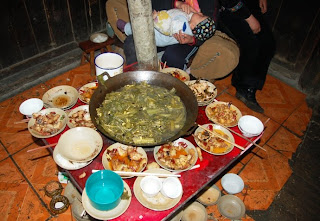Sumela Monastery was founded as early as 4th centry, re-builit and restored for many times in dfferent centuries, by different empire of Turkey. Devotional road is always not an easy journey of life. Many monasteries of different location and different religions share similarities, where they are mostly built in places away from cities, up on the hill slope, or hidden in forests and caves in order to provide a quiet place for prayers and learning.

Sumela Monastery was located in Macka region, and it is basically built into a steep slope of Karadaglar/Black Mountain. From the valley, visitors need to walk uphill for about 30 minutes to reach the entrance of the monastery. The journey is short, but many parts are quite a steep walk. There are plenty of maple tress along the way, and the colorful maple leaves beautifies my journey up to the monastery.

A long and narrow stairway leads me to the entrance of the monastery. Among the major elements in this monastery are the Rock Church, chapels, kitchen, student rooms, library, guest rooms and sacred spring. However, only limited compartments are opened to public/visitors.

The inner walls and outers wall of the Rock Church and chapels are decorated by frescoes. These frescoes were made as early as 13th century during the reign of Alexios III of Comnenian Empire of Trabzon. These fresoces can be in the inner wall of Rock Church.

There are different kind of frescoes used to decorate the early churches. Some are painted directly on the rock wall, while some are painted on to a thin layer of plasters on rocky wall, and this is the type observed in this monastery.

The frescoes found in this monastery are badly damaged, but the outline of the frescoes can still be observed clearly. The main subjects of these frescoes are biblical scenes, as well as stories of Jesus Christ and the Virgin Mary.

The outer wall of the church is filled with frescoes of various biblical scenes such as resurrection of Jesus Christ, etc. However, I notice that many frescoes of people are destroyed, with either both eyes or face gone. After I asked the guard stationed in this monastery about the reason, then I know that when Islam came to Turkey, many frescoes related to Christianity are destroyed by Muslims and in their belief, a being is represented by both eyes or face. Therefore, most of the frescoes ended up with both eyes or face gone.


Devotional road is always about faith. Look at how the devotees of the world, of various religions practice and devote themselves to the God or to what they believe. It is always a wonderful experience to visit religious places and learn about others' religions or belief.
Note : Aya Sofya Museum is also worth a visit in Trabzon. This is not the Aya Sofya in Istanbul.
































